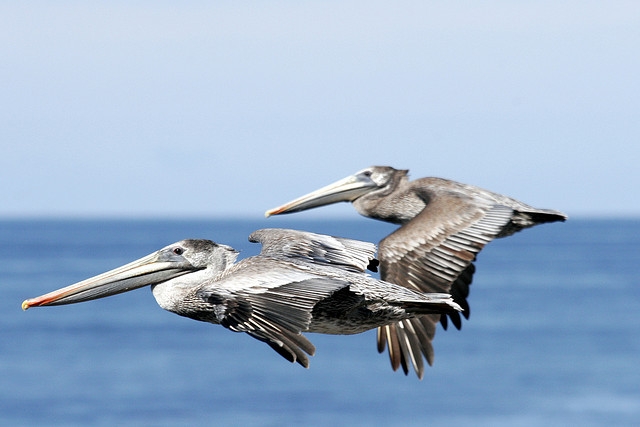28 — The Brown Pelican.
2015-07-12. By Kelly.

Fig. 1. Brown pelicans soar. Photo by Mike Baird, Flickr Creative Commons.
Brown Pelican is a Common Site at Bear Island.
It was six in the morning on Bear Island. Patrick and I sit in new comfy chairs while we eat our oatmeal and we drink our coffee on the beach. As the sun rises, we watch the shore birds forage along the beach. By nine the brown pelicans form a line coasting down the beach on air lifts off the waves or the dunes as we set up our tarp for the day. The brown pelican drift by us periodically throughout the day lazily cruising on the air lifts. I enjoy counting the number of individuals in each squadron that fly along the coast.
When I came back from Bear Island, I investigated the life history of the brown pelican and found that a brown pelicans can weigh from 2.75 to 5.5 kg. These birds are found on Islands, piers, and Jetties along both the East and West coasts of the United States.
I love watching these large birds fish. The pelicans fish by flying high in the air and diving down on the fish. The fish are stunned by the impact of the pelican. The brown pelican scoops up the stunned fish and dumps the water out of his beak before gulping the fish down its throat. Patrick and I could see the brown pelicans diving into the water just beyond the intertidal zone where the water was calmer and less murky.
Bear Island has two bird sanctuary that protect nesting area for many sea shore birds such as terns, oyster catchers, plovers, pelicans and many other bird species. We were not at Bear Island for the breeding and rearing of the brown pelican. However, I read on the Cornell Lab of Ornithology site that the male brown pelican builds a nest about 30 cm in diameter. The male then displays to attract a mate. Brown Pelicans lay two to three eggs. After the eggs are laid, the male and female brown pelican both rear the young. I also found from an interesting fact about the natural history of the brown pelican. In the 1960's, the brown pelican was once put on the endangered list due to the use of DDT. The DDT caused the eggs shells to be too thin to support the developing chick. Today, the brown pelican's populations have rebounded from the 1960's and they have been removed from the endangered list. Thankfully, the Bear Island ecosystem hosts a thriving brown pelican community today.
So next time you spend the day at the beach, or fishing along the coast, watch for these wonderful birds soring over the waves.